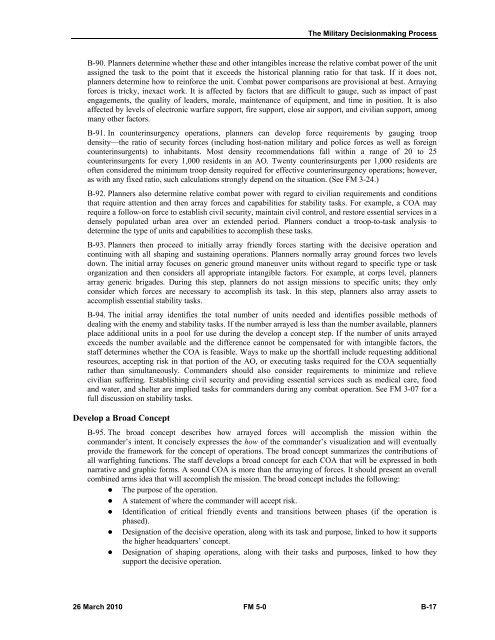FM 5-0, The Operations Process - Federation of American Scientists
FM 5-0, The Operations Process - Federation of American Scientists
FM 5-0, The Operations Process - Federation of American Scientists
Create successful ePaper yourself
Turn your PDF publications into a flip-book with our unique Google optimized e-Paper software.
<strong>The</strong> Military Decisionmaking <strong>Process</strong><br />
B-90. Planners determine whether these and other intangibles increase the relative combat power <strong>of</strong> the unit<br />
assigned the task to the point that it exceeds the historical planning ratio for that task. If it does not,<br />
planners determine how to reinforce the unit. Combat power comparisons are provisional at best. Arraying<br />
forces is tricky, inexact work. It is affected by factors that are difficult to gauge, such as impact <strong>of</strong> past<br />
engagements, the quality <strong>of</strong> leaders, morale, maintenance <strong>of</strong> equipment, and time in position. It is also<br />
affected by levels <strong>of</strong> electronic warfare support, fire support, close air support, and civilian support, among<br />
many other factors.<br />
B-91. In counterinsurgency operations, planners can develop force requirements by gauging troop<br />
density—the ratio <strong>of</strong> security forces (including host-nation military and police forces as well as foreign<br />
counterinsurgents) to inhabitants. Most density recommendations fall within a range <strong>of</strong> 20 to 25<br />
counterinsurgents for every 1,000 residents in an AO. Twenty counterinsurgents per 1,000 residents are<br />
<strong>of</strong>ten considered the minimum troop density required for effective counterinsurgency operations; however,<br />
as with any fixed ratio, such calculations strongly depend on the situation. (See <strong>FM</strong> 3-24.)<br />
B-92. Planners also determine relative combat power with regard to civilian requirements and conditions<br />
that require attention and then array forces and capabilities for stability tasks. For example, a COA may<br />
require a follow-on force to establish civil security, maintain civil control, and restore essential services in a<br />
densely populated urban area over an extended period. Planners conduct a troop-to-task analysis to<br />
determine the type <strong>of</strong> units and capabilities to accomplish these tasks.<br />
B-93. Planners then proceed to initially array friendly forces starting with the decisive operation and<br />
continuing with all shaping and sustaining operations. Planners normally array ground forces two levels<br />
down. <strong>The</strong> initial array focuses on generic ground maneuver units without regard to specific type or task<br />
organization and then considers all appropriate intangible factors. For example, at corps level, planners<br />
array generic brigades. During this step, planners do not assign missions to specific units; they only<br />
consider which forces are necessary to accomplish its task. In this step, planners also array assets to<br />
accomplish essential stability tasks.<br />
B-94. <strong>The</strong> initial array identifies the total number <strong>of</strong> units needed and identifies possible methods <strong>of</strong><br />
dealing with the enemy and stability tasks. If the number arrayed is less than the number available, planners<br />
place additional units in a pool for use during the develop a concept step. If the number <strong>of</strong> units arrayed<br />
exceeds the number available and the difference cannot be compensated for with intangible factors, the<br />
staff determines whether the COA is feasible. Ways to make up the shortfall include requesting additional<br />
resources, accepting risk in that portion <strong>of</strong> the AO, or executing tasks required for the COA sequentially<br />
rather than simultaneously. Commanders should also consider requirements to minimize and relieve<br />
civilian suffering. Establishing civil security and providing essential services such as medical care, food<br />
and water, and shelter are implied tasks for commanders during any combat operation. See <strong>FM</strong> 3-07 for a<br />
full discussion on stability tasks.<br />
Develop a Broad Concept<br />
B-95. <strong>The</strong> broad concept describes how arrayed forces will accomplish the mission within the<br />
commander’s intent. It concisely expresses the how <strong>of</strong> the commander’s visualization and will eventually<br />
provide the framework for the concept <strong>of</strong> operations. <strong>The</strong> broad concept summarizes the contributions <strong>of</strong><br />
all warfighting functions. <strong>The</strong> staff develops a broad concept for each COA that will be expressed in both<br />
narrative and graphic forms. A sound COA is more than the arraying <strong>of</strong> forces. It should present an overall<br />
combined arms idea that will accomplish the mission. <strong>The</strong> broad concept includes the following:<br />
• <strong>The</strong> purpose <strong>of</strong> the operation.<br />
• A statement <strong>of</strong> where the commander will accept risk.<br />
• Identification <strong>of</strong> critical friendly events and transitions between phases (if the operation is<br />
phased).<br />
• Designation <strong>of</strong> the decisive operation, along with its task and purpose, linked to how it supports<br />
the higher headquarters’ concept.<br />
• Designation <strong>of</strong> shaping operations, along with their tasks and purposes, linked to how they<br />
support the decisive operation.<br />
26 March 2010 <strong>FM</strong> 5-0 B-17















